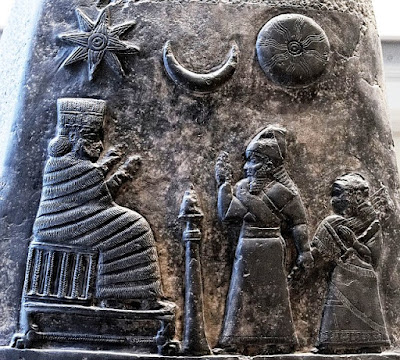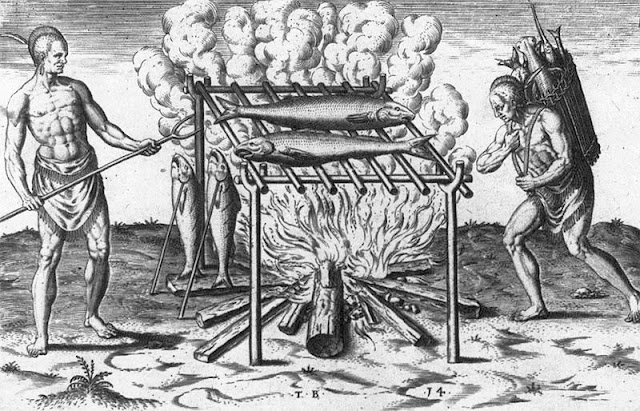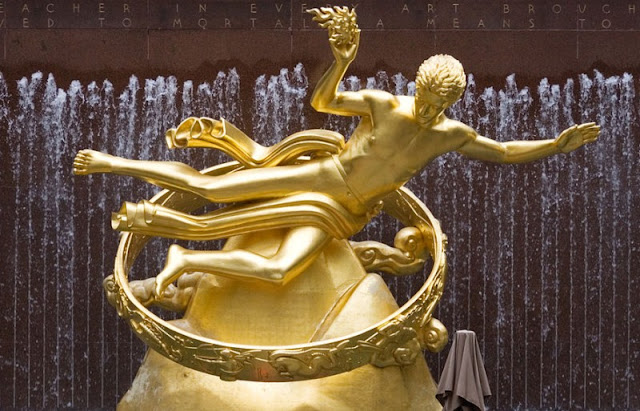THE BIRTH OF GODS IN THE NEOLITHIC
A Response to the Ideas of Jacques Cauvin
Detail: Prometheus creating and giving life to man as the other gods look on.
" 'Creation of the Man' by Prometheus, 4th-c.CE Roman sarcophagus. Marble."
https://commons.wikimedia.org/wiki/File:MANNapoli_6705_creation_of_the_man_sarcophagus.jpg
" 'Creation of the Man' by Prometheus, 4th-c.CE Roman sarcophagus. Marble."
https://commons.wikimedia.org/wiki/File:MANNapoli_6705_creation_of_the_man_sarcophagus.jpg
When I read about this theory I was intrigued because -- without knowing about his work -- four years ago in 2013, I had written that another revolution of thought had occurred perhaps 50,000 years ago during the Paleolithic old-stone-age caveman era. And I believe it was this revolution that has determined our way of life ever since then.
See my blog: Science Vs. Faith, Religion and Belief
THE FUNDAMENTAL & REVOLUTIONARY IDEA IS THIS:
From the most 'primitive' beliefs to the most modern religions and science,
in all cultures, and all civilizations across the globe,
there was/is an underlying uniquely human logic:
There are forces
in the external reality
outside of human beings
which can be known
and once known can be influenced
This is the central idea that has guided and propelled human culture and civilization ever since. This idea allowed us to create agriculture in the Neolithic era and to send rockets to the moon in the 20th century. This idea was true for shamanistic religions, for polytheism and monotheism and is also true for science today. In fact it is the cornerstone of science.
Like Cauvin, I think this belief came first. So at the beginning of this period of development, humankind needed to believe the spirits were knowable. This faith then led to increased skills and knowledge. All of this was motivated by a basic animal instinct, the instinct for survival. Gaining knowledge and power meant that humans would have a better chance of surviving.
Left: God the Geometer, i.e., the creator of an orderly Universe we can know as human beings.
"(circa 1220-1230) Science, and particularly geometry and astronomy/astrology, was linked directly to the divine for most medieval scholars. The compass in this 13th century manuscript is a symbol of God's act of Creation. God has created the universe after geometric and harmonic principles, to seek these principles was therefore to seek and worship God." https://commons.wikimedia.org/wiki/File:God_the_Geometer.jpg
Right: A painting from William Blake's Europe a Prophecy, Creation of the World.
"God in "The Ancient of Days" is a "nous" figure, a creative principle in the universe that establishes mathematical order and permanence that allows life to keep from becoming nothingness." https://en.wikipedia.org/wiki/Europe_a_Prophecy
To see my thinking about this in detail
read the rest of this blog
In 1994 French archaeologist Jacques Cauvin published his masterwork The Birth of the Gods and the Origins of Agriculture. Writing about the transition from Paleolithic to Neolithic, he put forward a radical idea. He claimed that before the Neolithic Revolution could occur and before agriculture could change the life of humans forever, there was a mental and psychological revolution, a "Revolution of the Symbols." He wrote that this thought-revolution had to occur first before the physical revolution of planting and domesticating animals came about, i.e., the Neolithic Revolution which led to cities and civilizations and the world we live in today.
He argued that this shift in thinking from nomadic hunter-gatherer Paleolithic peoples to agricultural sedentary Neolithic farmers had to do with a fundamental change in religious ideas. This new religion involved a conception of personalized anthropomorphic divinities that treated humans as special creatures, and so gave humans a different sense of themselves and their life on this Earth. Their relationship with these gods or God led to an understanding that humans were unique among the animals which then allowed humans to domesticate animals, to shape their own environment and in a sense to shape their own destiny. Humans identified with these gods and like the gods saw themselves as above nature. Humans believed the gods had given them power over nature so they could begin to shape and control natural forces. For example, if it did not rain, farmers learned to irrigate their crops.
Woodcut for "Die Bibel in Bildern" by Julius Schnorr von Carolsfeld, 1860.
In the Book of Genesis. Chapter 1, God gives humankind power over the animals:
26 Then God said, “Let us make humankind in our image, after our likeness, so they may rule over the fish of the sea and the birds of the air, over the cattle, and over all the earth, and over all the creatures that move on the earth.” 27 God created humankind in his own image,
in the image of God he created them,
male and female he created them.
New English Translation of the Bible
At the same time, this new relationship meant that humans also felt disconnected from the natural world that they had been a part of at the beginning of the Paleolithic era.
When Jacques Cauvin proposed this idea, it was startling. Archaeologists and researchers had all assumed that the Neolithic age began due to economic factors because farming seemed like the best strategy for survival.
One of the 11,000-year-old columns found at Gobekli Tepe in Turkey,
made with stone tools before the Neolithic Revolution.
https://en.wikipedia.org/wiki/G%C3%B6bekli_Tepe
https://en.wikipedia.org/wiki/G%C3%B6bekli_Tepe
Then in the same year that Cauvin's book came out, a major discovery seemed to confirm his ideas. A huge sophisticated pre-Neolithic complex in Turkey, called Gobekli Tepe, was found that had been buried for 11,000 years. After it was initially excavated, the evidence showed that it had been used by hunter-gatherers but contained huge straight, tall, finely finished stone columns and stone carvings of animals. All of this was crafted with stone tools. The quality of the workmanship was superb. Yet the people were not at the Neolithic point of development. The site appeared to be a religious gathering place that was used regularly by hunter-gatherers who did not live there. Klaus Schmidt, who was in charge of the archeological dig, said it was a "cathedral on a hill" and then later added "First came the temple, then the city," thus confirming Jacques Cauvin's principle idea.
When I recently came across these ideas of Jacques Cauvin, I was fascinated, because I had written blogs about the same subject. Many of my ideas were similar to his which I did not know at the time. My ideas are as follows.
Long before the Neolithic age, I believe there was an even more basic, fundamental shift in our symbols, one that happened early in our development, one that has determined our way of life and our fate ever since. And this change had to occur first before Cauvin's "Revolution of the Symbols" could take hold. In fact, Cauvin's theory of a shift to personalized divinities required the more fundamental shift that I wrote about. How did this happen? Read on.
Adam Naming the Animals by Jan Brueghel the Younger, 17th century, oil on copper.
https://commons.wikimedia.org/wiki/File:Jan_Breughel_de_Jonge_-_De_geschiedenis_van_Adam_en_Eva.jpg
19 The Lord God formed out of the ground every living animal of the field and every bird of the air. He brought them to the man to see what he would name them, and whatever the man called each living creature, that was its name.
19 The Lord God formed out of the ground every living animal of the field and every bird of the air. He brought them to the man to see what he would name them, and whatever the man called each living creature, that was its name.
20 So the man named all the animals, the birds of the air, and the living creatures of the field
The Book of Genesis, Chapter 2, New English Translation of the Bible
In most hunter-gatherer cultures:"There are invariably two temporal orders of existence, with an Early mythical or 'dreamtime' preceding the present. In the former, nature and culture are not yet fully separated. Out of this existence...crystallizes the distinction between humans and animals, even mortality itself, and virtually everything of cultural significance." Introduction: The Cambridge Encyclopedia of HUNTERS AND GATHERERS
AN EARLIER REVOLUTION OF RELIGIOUS BELIEF
First:
When homo sapiens sapiens evolved (meaning us modern humans) they/we were given a unique part of the brain that dealt with time. No other animal has this.
"This ability to hold on to a piece of information temporarily in order to complete a task is specifically human. [ED: my emphasis] It causes certain regions of the brain to become very active, in particular, the pre-frontal lobe. This region, at the very front of the brain, is highly developed in humans. It is the reason that we have such high, upright foreheads, compared with the receding foreheads of our cousins the apes. Hence it is no surprise that the part of the brain that seems most active during one of the most human of activities [ED: short-term memory] is located precisely in this prefrontal region that is well developed only in human beings."Perhaps the most extreme example of short-term memory is a chess master who can explore several possible solutions mentally before choosing the one that will lead to checkmate." SHORT-TERM MEMORY': McGill University, Montreal, Canada http://thebrain.mcgill.ca/flash/d/d_07/d_07_cr/d_07_cr_tra/d_07_cr_tra.html
See my blog: Animal Senses Compared to the Human Sense of Time
I think it is quite possible that the human brain's unique ability to consider future actions in the short term became a model for time itself. This short-term understanding of time could have been developed and expanded through language and symbolism to include time in the long term. So the skill of considering whether to go right or left in the heat of a hunt could, over thousands of years, be extended to considering whether to go to the river or the mountains by the next full moon, for example.
The next three steps probably happened over and over and went around and around and back and forth. Which came first or which led to which is difficult to determine. I suspect that it was a what-came-first-the-chicken-or-the-egg type of situation.
Second:
Because of our ability to perceive time, we began to see patterns.
I believe the human sense of time -- hundreds of thousands of years before civilization began -- gave us the edge as a species. Because without an ability to recall the past, we would not have the data necessary to discern a pattern. Before we could perceive patterns we had to have had a clear memory and a detailed understanding of what we had seen and experienced so we could connect the dots. Yet the combination of the two: a sophisticated understanding of time combined with a sophisticated perception of patterns, gave us a tremendous advantage.
There is another aspect to perceiving patterns. For example, knowing astronomical patterns gave humans predictive power. Once people saw a certain star(s) appear they learned to predict how the weather and seasons would change. This ability to predict the future gave humans a godlike power that no other animal had.
See my blog: Patterns & Memory
The return of the Pleiades (halfway up on the left) every year was a major event in many cultures as it often marked the beginning of the rainy season and for some was the beginning of the new year. Since there was a distinct seasonal change when it appeared, it was also given godlike powers and treated with reverence in many religions.
According to Wikipedia, the Pleiades was known to "the Maori, Aboriginal Australians, the Persians, the Chinese, the Japanese, the Maya, the Aztec, and the Sioux and Cherokee." as well as the Greeks. When the Pleiades first appeared in the night sky -- which lasted only a few minutes at the beginning of its annual reappearance -- indigenous tribes often greeted it with wild celebrations. Yet their ability to mark time was sophisticated enough that they knew exactly when to first look for the Pleiades even though it appeared over the horizon very briefly at first. This first sighting of a key star or stars right at dawn for a few minutes is known as the heliacal rising. It required a good deal of skill and this moment was considered sacred by many peoples.
https://commons.wikimedia.org/wiki/File:NATIVES_HAILING_THE_RE-APPEARANCE_OF_THE_PLEIADES.png
https://commons.wikimedia.org/wiki/File:NATIVES_HAILING_THE_RE-APPEARANCE_OF_THE_PLEIADES.png
Third:
Symbolism and the beginnings of religion:
We know from burial evidence that humans were beginning to have religious thoughts as early as 100,000 years ago. Burial rites are often seen by anthropologists as a sign of religious rituals.
"The earliest undisputed human burial dates back 100,000 years. Human skeletal remains stained with red ochre were discovered in the Skhul cave and Qafzeh, Israel." https://en.wikipedia.org/wiki/Paleolithic_religionAt some point, perhaps around 50,000 years ago, there was a major shift in the way humans operated. Known as "symbolic culture" or the "human revolution," it referred to: The symbolic world of shared language and concepts that each one of us carries within us and is a creation of our culture.
"Symbolic culture is a domain of objective facts whose existence depends, paradoxically, on collective belief. [ED: such as money or marriage]
"Long before the late twentieth-century invention of the Internet, evolution allowed humans to flit between two realms, reality on the one hand, virtual reality on the other. Symbolic culture is an environment of virtual entities lacking counterparts in the real world."
https://en.wikipedia.org/wiki/Symbolic_culture
"Symbolism was not an optional extra – life following the transition became fundamentally organized through symbols." (A summation of the thinking of Christopher Henshilwood and Ian Watts)
https://en.wikipedia.org/wiki/The_Human_Revolution_(human_origins)
As the ability to work with symbols advanced, humans noticed more patterns and gained more control. When the ability to perceive patterns allowed humans to make predictions, a religious explanation often accompanied the observations. Science and religion were inseparable from the beginning. Knowing and celebrating the winter solstice was both an astronomical event and a religious time, for example.
As consciousness, language, and symbolism developed, humans became aware that they were quite different from all the other animals. They walked upright, they did not have fur, they used fire and tools and they spoke a language. As a result, they wondered why they were so distinct and more intelligent. My guess is that humans began to think of themselves as special and as having a special purpose. The development of religion helped explain why they were special and also the reason they were put on the Earth.
See my blog: The Human Revolution: Symbolic Culture
See my blog: How Our Concept of Time Is Embedded & Derived from Our Language
See my blog: Virtual Human Meta-Time
NOTE: This idea of being special was probably a feeling that was not well articulated in the beginning. However, around the time of the Neolithic, as Cauvin suggested, it burst into bloom and a fully developed mythology arose with powerful human-like divinities. It was believed that gods or God created human beings in their own image or acted as their guardians or mentors. See the Afterword in this blog.
12th-13th century Mosaic.
God giving life to Adam. A story that is sacred to Jews, Christians, and Moslems.
"Monreale, Sicily: cathedral, mosaic of the creation of Adam"
https://commons.wikimedia.org/wiki/File:Monreale_-_Kathedrale_Mosaik_Adam_01.JPG
"Monreale, Sicily: cathedral, mosaic of the creation of Adam"
https://commons.wikimedia.org/wiki/File:Monreale_-_Kathedrale_Mosaik_Adam_01.JPG
Fourth:
Religion
All religions, arts and sciences are branches of the same tree.
Albert Einstein
Like most behaviors that are found in societies throughout the world, religion must have been present in the ancestral human population before the dispersal from Africa 50,000 years ago. Although religious rituals usually involve dance and music, they are also very verbal, since the sacred truths have to be stated. If so, religion, at least in its modern form, cannot pre-date the emergence of language. Nicholas Wade https://en.wikipedia.org/wiki/Evolutionary_origin_of_religions
From what we know about recent and contemporary hunter-gatherers, the first religions were shamanistic. "A shaman is someone who is regarded as having access to, and influence in, the world of benevolent and malevolent spirits..."
https://en.wikipedia.org/wiki/Shamanism
See my blog: Time & Consciousness
See my blog: The Development of Consciousness & the Origins of Religion
See my blog: Creation Myths and Consciousness
All religions, from the very beginning, contained a fundamental assumption about the human relation to the gods or the spirit world.
The following underlying assumption has been part of religion and science and guided human development. This is the central idea that has propelled human culture and civilization ever since. This was true for shamanistic religions, for polytheism and monotheism and is also true for science today.
THE FUNDAMENTAL IDEA IS THIS:
From the most 'primitive' beliefs to the most modern religions and science,
in all cultures, and all civilizations across the globe,
there was/is an underlying uniquely human logic:
There are forces
in the external reality
outside of human beings
which can be known
and once known can be influenced
This idea allowed us to create agriculture in the Neolithic era and to send rockets to the moon in the 20th century. Like Cauvin, I think this belief came first. So at the beginning of this period of development, humankind needed to believe the spirits were knowable. This faith then led to increased skills and knowledge. All of this was motivated by a basic animal instinct, the instinct for survival. Gaining knowledge and power meant that humans would have a better chance of surviving.
AFTERWORD
Other people may have different ideas about how and why this happened. I welcome additional models. But I believe my basic concept is sound.
Also I would like to add: Its been only about 350 years ago since science and religion were closely intertwined. The break between the two began in the 17th century. In 1661 the clear difference between chemistry and alchemy was elucidated in the book The Sceptical Chymist by Robert Boyle. Newton's discovery of the precise laws of motion and gravity (published 1687) also spawned a very different idea of God, i.e., God the great watchmaker of the Universe.
Yet for thousands of years, scientific observations such as the motions of the planets and their identification with the gods were part of human thinking. For example, the ability to determine the exact time of the winter solstice was both an astronomical achievement and a time for religious celebrations. BTW this intertwining is still true today with Christmas in the West occurring just days after the winter solstice.
Babylonians were making careful scientific observations of the planet Venus and recording them on these clay tablets. At the same time, the goddess Ishtar (next two images) was associated with the planet Venus. This shows the connection between knowledge, science, and religion.
FROM WIKIPEDIA
"The Venus tablet of Ammisaduqa (Enuma Anu Enlil Tablet 63) refers to the record of astronomical observations of Venus, as preserved in numerous cuneiform tablets dating from the first millennium BCE. It is believed that this astronomical record was first compiled during the reign of King Ammisaduqa (or Ammizaduga), the fourth ruler after Hammurabi. Thus, the origins of this text should probably be dated to around the mid-seventeenth century BCE. (according to the Middle Chronology).
"The tablet recorded the rise times of Venus and its first and last visibility on the horizon before or after sunrise and sunset (the heliacal risings and settings of Venus) in the form of lunar dates. These observations are recorded for a period of 21 years."
Grey-black limestone material:
The star, top left, was the symbol for the goddess Ishtar -- see her picture next.
The star, top left, was the symbol for the goddess Ishtar -- see her picture next.
"(1186–1172 BCE): The king presents his daughter to the goddess Nannaya.
The crescent moon represents the god Sin, the sun the Shamash and the star the goddess Ishtar."
The sacred, powerful and central Babylonian goddess Ishtar.
Her symbol was the star and she was associated with the planet Venus.
" 'Burney Relief' ...from about 1800-1750 BC."
https://commons.wikimedia.org/wiki/File:Burney_Relief_Babylon_-1800-1750.JPG
" 'Burney Relief' ...from about 1800-1750 BC."
https://commons.wikimedia.org/wiki/File:Burney_Relief_Babylon_-1800-1750.JPG
See my blog about the prehistoric use of science:
Computing the Winter Solstice at Newgrange:
Was Neolithic Science Equal to or Better Than Ancient Greek or Roman Science?
























